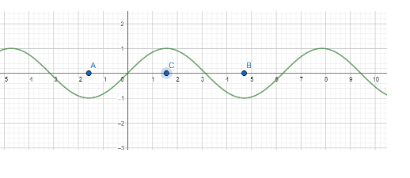
Prove that ${{\sin }^{-1}}\left( \dfrac{1}{x} \right)={{\csc }^{-1}}x,x\in \left( -\infty ,-1 \right]\bigcup \left[ 1,\infty \right)$
Answer
591.9k+ views
Hint: Use the fact that if $y={{\sin }^{-1}}x$, then $x=\sin y$. Assume $y={{\sin }^{-1}}\left( \dfrac{1}{x} \right)$. Use the previously mentioned fact and write x in terms of y. ]. Take ${{\sec }^{-1}}$ on both sides and use the fact that if $y\in \left[ -\dfrac{\pi }{2},\dfrac{\pi }{2} \right]-\left\{ 0 \right\}$, then ${{\csc }^{-1}}\left( \csc y \right)=y$ and hence prove the result.
Complete step-by-step answer:
Before dwelling into the proof of the above question, we must understand how ${{\sin }^{-1}}x$ is defined even when $\sin x$ is not one-one.
We know that sinx is a periodic function.
Let us draw the graph of sinx

As is evident from the graph sinx is a repeated chunk of the graph of sinx within the interval $\left[ A,B \right]$ , and it attains all its possible values in the interval $\left[ A,C \right]$. Here $A=\dfrac{-\pi }{2},B=\dfrac{3\pi }{2}$ and $C=\dfrac{\pi }{2}$
Hence if we consider sinx in the interval [A, C], we will lose no value attained by sinx, and at the same time, sinx will be one-one and onto.
Hence ${{\sin }^{-1}}x$ is defined over the domain $\left[ -1,1 \right]$, with codomain $\left[ \dfrac{-\pi }{2},\dfrac{\pi }{2} \right]$ as in the domain $\left[ \dfrac{-\pi }{2},\dfrac{\pi }{2} \right]$, sinx is one-one and ${{R}_{\sin x}}=\left[ -1,1 \right]$.
Now since ${{\sin }^{-1}}x$ is the inverse of sinx it satisfies the fact that if $y={{\sin }^{-1}}x$, then $\sin y=x$.
So let $y={{\sin }^{-1}}\left( \dfrac{1}{x} \right)$, $y\in \left[ -\dfrac{\pi }{2},\dfrac{\pi }{2} \right]-\left\{ 0 \right\}$ as $\dfrac{1}{x}\ne 0$
Hence we have $\sin y=\dfrac{1}{x}$
Hence we have $x=\dfrac{1}{\sin y}=\csc y$
Taking ${{\csc }^{-1}}$ on both sides, we get
${{\csc }^{-1}}x={{\csc }^{-1}}\left( \csc y \right)$
Now since $y\in \left[ -\dfrac{\pi }{2},\dfrac{\pi }{2} \right]-\left\{ 0 \right\}$ and we know that if $y\in \left[ -\dfrac{\pi }{2},\dfrac{\pi }{2} \right]-\left\{ 0 \right\}$, then ${{\csc }^{-1}}\left( \csc y \right)=y$ [Valid only in principal branch]
Hence we have
$\begin{align}
& {{\csc }^{-1}}x=y \\
& \Rightarrow y={{\csc }^{-1}}y \\
\end{align}$
Reverting to the original variable, we get
${{\sin }^{-1}}\left( \dfrac{1}{x} \right)={{\csc }^{-1}}\left( x \right)$
Since $\dfrac{1}{x}$ is in the domain of ${{\sin }^{-1}}x$, we get
$\dfrac{1}{x}\in \left[ -1,1 \right]\Rightarrow x\in \left( -\infty ,-1 \right]\bigcup \left[ 1,\infty \right)$
Hence we have ${{\sin }^{-1}}\left( \dfrac{1}{x} \right)={{\csc }^{-1}}x,x\in \left( -\infty ,-1 \right]\bigcup \left[ 1,\infty \right)$
Note: [1] The above-specified codomain for ${{\sin }^{-1}}x$ is called principal branch for ${{\sin }^{-1}}x$. We can select any branch as long as $\sin x$ is one-one and onto and Range $=\left[ -1,1 \right]$. Like instead of $\left[ -\dfrac{\pi }{2},\dfrac{\pi }{2} \right]$, we can select the interval $\left[ \dfrac{\pi }{2},\dfrac{3\pi }{2} \right]$. The proof will remain the same as above.
Complete step-by-step answer:
Before dwelling into the proof of the above question, we must understand how ${{\sin }^{-1}}x$ is defined even when $\sin x$ is not one-one.
We know that sinx is a periodic function.
Let us draw the graph of sinx

As is evident from the graph sinx is a repeated chunk of the graph of sinx within the interval $\left[ A,B \right]$ , and it attains all its possible values in the interval $\left[ A,C \right]$. Here $A=\dfrac{-\pi }{2},B=\dfrac{3\pi }{2}$ and $C=\dfrac{\pi }{2}$
Hence if we consider sinx in the interval [A, C], we will lose no value attained by sinx, and at the same time, sinx will be one-one and onto.
Hence ${{\sin }^{-1}}x$ is defined over the domain $\left[ -1,1 \right]$, with codomain $\left[ \dfrac{-\pi }{2},\dfrac{\pi }{2} \right]$ as in the domain $\left[ \dfrac{-\pi }{2},\dfrac{\pi }{2} \right]$, sinx is one-one and ${{R}_{\sin x}}=\left[ -1,1 \right]$.
Now since ${{\sin }^{-1}}x$ is the inverse of sinx it satisfies the fact that if $y={{\sin }^{-1}}x$, then $\sin y=x$.
So let $y={{\sin }^{-1}}\left( \dfrac{1}{x} \right)$, $y\in \left[ -\dfrac{\pi }{2},\dfrac{\pi }{2} \right]-\left\{ 0 \right\}$ as $\dfrac{1}{x}\ne 0$
Hence we have $\sin y=\dfrac{1}{x}$
Hence we have $x=\dfrac{1}{\sin y}=\csc y$
Taking ${{\csc }^{-1}}$ on both sides, we get
${{\csc }^{-1}}x={{\csc }^{-1}}\left( \csc y \right)$
Now since $y\in \left[ -\dfrac{\pi }{2},\dfrac{\pi }{2} \right]-\left\{ 0 \right\}$ and we know that if $y\in \left[ -\dfrac{\pi }{2},\dfrac{\pi }{2} \right]-\left\{ 0 \right\}$, then ${{\csc }^{-1}}\left( \csc y \right)=y$ [Valid only in principal branch]
Hence we have
$\begin{align}
& {{\csc }^{-1}}x=y \\
& \Rightarrow y={{\csc }^{-1}}y \\
\end{align}$
Reverting to the original variable, we get
${{\sin }^{-1}}\left( \dfrac{1}{x} \right)={{\csc }^{-1}}\left( x \right)$
Since $\dfrac{1}{x}$ is in the domain of ${{\sin }^{-1}}x$, we get
$\dfrac{1}{x}\in \left[ -1,1 \right]\Rightarrow x\in \left( -\infty ,-1 \right]\bigcup \left[ 1,\infty \right)$
Hence we have ${{\sin }^{-1}}\left( \dfrac{1}{x} \right)={{\csc }^{-1}}x,x\in \left( -\infty ,-1 \right]\bigcup \left[ 1,\infty \right)$
Note: [1] The above-specified codomain for ${{\sin }^{-1}}x$ is called principal branch for ${{\sin }^{-1}}x$. We can select any branch as long as $\sin x$ is one-one and onto and Range $=\left[ -1,1 \right]$. Like instead of $\left[ -\dfrac{\pi }{2},\dfrac{\pi }{2} \right]$, we can select the interval $\left[ \dfrac{\pi }{2},\dfrac{3\pi }{2} \right]$. The proof will remain the same as above.
Recently Updated Pages
A man running at a speed 5 ms is viewed in the side class 12 physics CBSE

The number of solutions in x in 02pi for which sqrt class 12 maths CBSE

State and explain Hardy Weinbergs Principle class 12 biology CBSE

Write any two methods of preparation of phenol Give class 12 chemistry CBSE

Which of the following statements is wrong a Amnion class 12 biology CBSE

Differentiate between action potential and resting class 12 biology CBSE

Trending doubts
What are the major means of transport Explain each class 12 social science CBSE

Which are the Top 10 Largest Countries of the World?

Draw a labelled sketch of the human eye class 12 physics CBSE

How much time does it take to bleed after eating p class 12 biology CBSE

Explain sex determination in humans with line diag class 12 biology CBSE

Explain sex determination in humans with the help of class 12 biology CBSE




